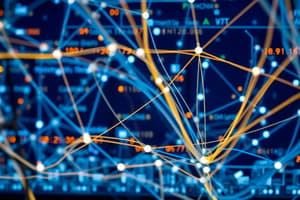Podcast
Questions and Answers
What is the primary function of a Network Interface Card?
What is the primary function of a Network Interface Card?
- To enable a computer to connect to a network. (correct)
- To store data permanently.
- To encrypt data transmissions.
- To facilitate wireless connections only.
Which type of network typically connects devices within a single building?
Which type of network typically connects devices within a single building?
- MAN
- LAN (correct)
- CAN
- WAN
What characterizes a peer-to-peer network?
What characterizes a peer-to-peer network?
- It contains a central server managing all communications.
- It is exclusively for high-speed data transmissions.
- Each peer can request and provide resources independently. (correct)
- It requires a special type of cable for connection.
In which topology do all nodes connect to a single central cable?
In which topology do all nodes connect to a single central cable?
What is a major disadvantage associated with network communications?
What is a major disadvantage associated with network communications?
Which term describes a communication rule set that governs interaction between computers?
Which term describes a communication rule set that governs interaction between computers?
What type of transmission system uses cables like twisted wire and coaxial cable?
What type of transmission system uses cables like twisted wire and coaxial cable?
Which statement is true regarding the advantages of networks?
Which statement is true regarding the advantages of networks?
Flashcards
Computer Network
Computer Network
A group of computers connected to share data, resources and communicate with each other.
End Devices
End Devices
Devices that start or end a network connection, such as PCs, tablets, and printers.
Intermediary Nodes
Intermediary Nodes
Devices like routers and switches that connect different parts of a network and help move data between them.
Transmission System
Transmission System
Signup and view all the flashcards
Network Interface Card (NIC)
Network Interface Card (NIC)
Signup and view all the flashcards
Protocols
Protocols
Signup and view all the flashcards
Network Topology
Network Topology
Signup and view all the flashcards
Client-Server Network
Client-Server Network
Signup and view all the flashcards
Study Notes
Computer Network
- A group of computers connected to exchange information.
- Devices can include computers, servers, printers, and security cameras.
- Communication links include wired cables and wireless links which carry the information.
Components of a Network
- End devices are the starting or ending point of a network.
- Examples include PCs, printers, servers, tablets, and smartphones.
- Intermediary nodes deliver data and connect multiple networks.
- Examples include routers, cell towers, and wireless routers.
Transmission System
- Sending data from one place to another.
- Guided (wired) transmission methods include twisted wire, coaxial cable, and optical fiber.
- Unguided (wireless) transmission methods use free space.
Network Interface Card (NIC)
- A piece of hardware that enables a computer to connect to a network.
- Also known as an adapter.
Protocols
- A set of rules that govern communication between computers.
- Examples include password based authentication protocols.
Advantages of Networking
- Easy access to shared resources.
- More flexibility in a work environment.
- Use of servers to protect data.
Disadvantages of Networking
- Loss of productivity due to security issues or troubleshooting.
- Risks of hacking, viruses, and other security threats.
- Complex implementation.
Network Classification
- Host Role:
- Client-Server: Clients request information from servers.
- Peer to Peer: All devices can share data and resources without a central server.
- Geography:
- LAN (Local Area Network): Devices in a single location (building, office, home).
- WAN (Wide Area Network): Connects LANs over large geographical areas.
- MAN (Metropolitan Area Network): Connects computers within a metropolitan area.
- Participation:
- Private network: Uses a private address space of IP addresses.
- Signaling:
- Baseband: Only one digital signal can be transmitted at a time.
- Broadband: Multiple digital signals can be transmitted simultaneously.
Network Topology
- Point to Point: Direct link between two computers.
- Advantages: Fast and reliable.
- Disadvantages: Limited scale.
- Bus Topology:
- Single main cable for all nodes and a central server.
- Advantages: Easy connection, low cost, and easy to add devices.
- Disadvantages: High traffic can cause slowdowns, and a cable break can disrupt the entire network.
Studying That Suits You
Use AI to generate personalized quizzes and flashcards to suit your learning preferences.




